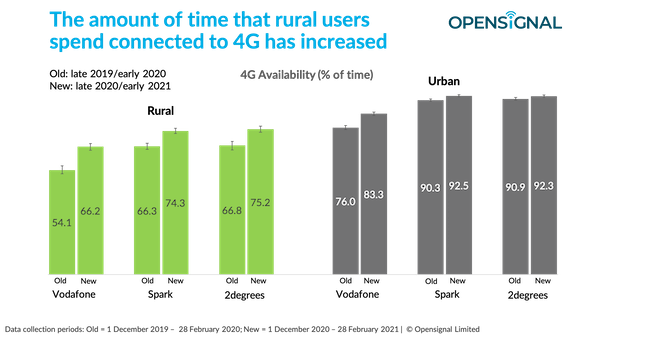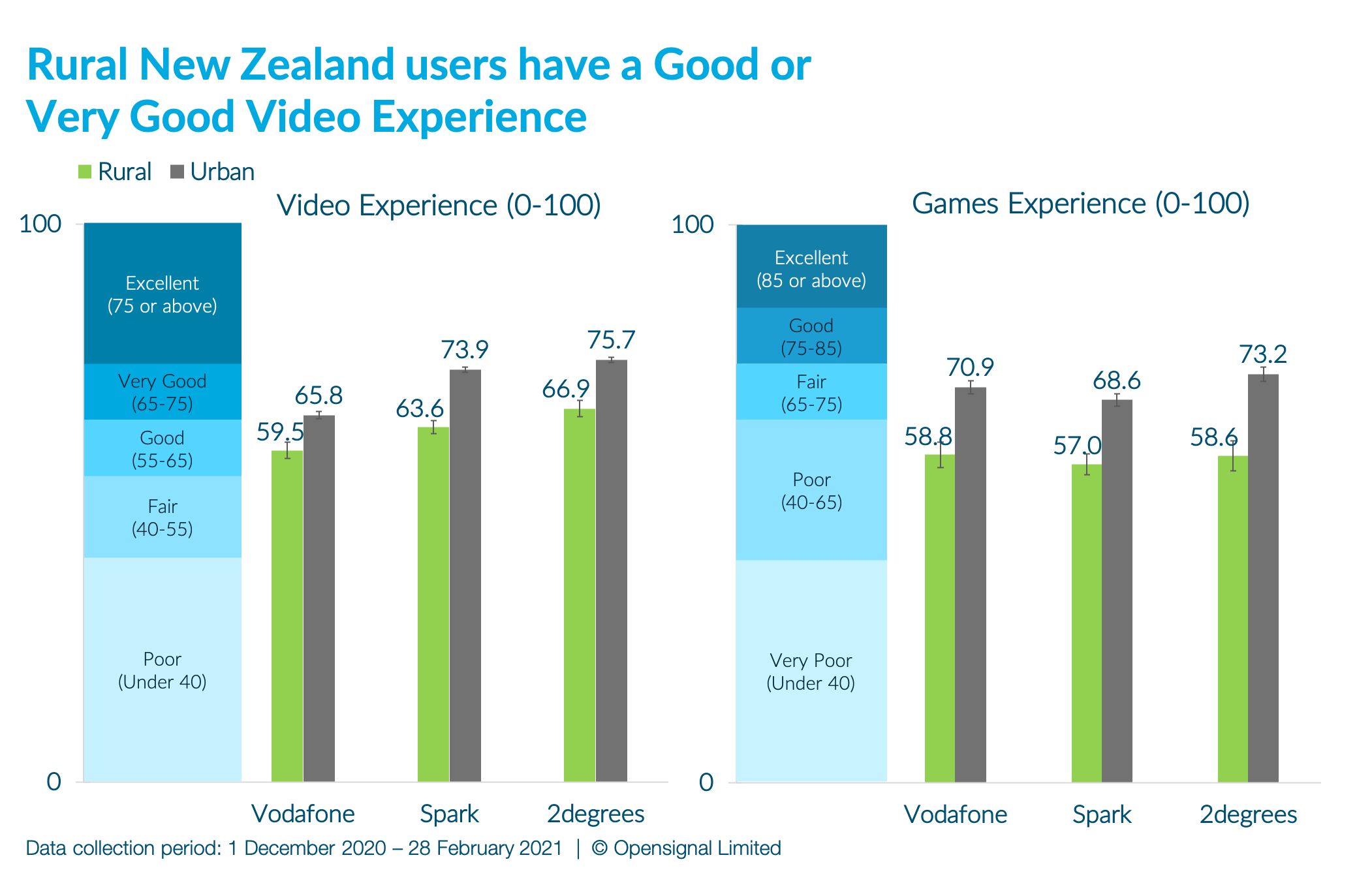Opensignal’s latest analysis of New Zealand’s mobile experience reveals notable disparities in our users’ experience between urban and rural areas on three major operators: Spark, 2degrees and Vodafone. However, the rural experience is clearly improving, likely as a result of government and operator efforts. But 5G threatens to complicate the rural-urban picture further, unless both government and operators use 5G to further boost the rural experience.
New Zealand’s mobile network operators have continued to invest in their rural networks to resolve these differences. The government supports moves to reduce the urban-rural divide with its Rural Broadband Initiatives (RBI) and Mobile Black Spot Fund (MBSF). Through these plans, the government has contracted the Rural Connectivity Group (RCG) — a joint venture between 2degrees, Spark and Vodafone — to deploy more than 500 cell sites to improve rural connectivity and the operators will share spectrum as part of this initiative. The RCG said that it went live with its 200th cell site in late February 2021 and hit the 100 cell site mark in June 2020.
For this analysis, we have used rural and urban geographic definitions created by Stats NZ Tatauranga Aotearoa.
The New Zealand rural-urban mobile divide is shrinking

The proportion of time that our rural users spent connected to 4G — 4G Availability — has increased significantly across all three operators. The rural/urban gap in 4G Availability shrunk by an impressive 7.0 percentage points for our 2degrees users, 5.8 for those on Spark and by 4.8 for our Vodafone users. These changes occurred despite the fact that 4G Availability improved over the same period for urban users on all three operators’ networks.
Higher 4G Availability indicates mobile users are spending less time connected to inferior older network technologies or without a mobile signal. In late 2019/early 2020, Vodafone, Spark and 2degrees’ 4G Availability scores in rural areas trailed behind those seen in urban areas by 21.9 – 24.1 percentage points. One year later, this spread had narrowed to 17.1 percentage points for both Vodafone and 2degrees and 18.2 percentage points for Spark.
The urban/rural divide extends to our users' video and games experience
Video Experience in New Zealand’s urban areas ranged between Very Good (65-75) and Excellent (75 or above), while in rural areas it ranged between Good (55-65) and Very Good (65-75). An Excellent rating means that there was a very consistent experience across all users, video streaming providers and resolutions tested, with fast loading times and almost non-existent stalling. And as we descend to lower categories, loading times lengthen, and users encounter more stops and stutters in the video stream.
In urban areas, our 2degrees users had an Excellent (75 or above) experience while our Spark and Vodafone users had a Very Good Video Experience when streaming videos using cellular data. By comparison, in rural areas, the Video Experience on 2degrees dropped down to Very Good, while that on Vodafone and Spark placed in the Good category.
Our analysis of Games Experience shows that playing multiplayer mobile games over a cellular connection can be challenging in both urban and rural areas regardless of the choice of operator. The Games Experience of our users, on all three networks, in the urban areas placed in the Fair category (65-75); while in rural areas, the Games Experience fell into the Poor category (40-65). Operators seeking to improve their rural subscribers’ experience when playing mobile multiplayer games and differentiate themselves from their rivals in this regard could do so by working to reduce latency, jitter and packet loss — as all three adversely affect Games Experience.
There’s still room to improve and the government is right to help rural areas

The average download speeds observed in rural areas were between 32 and 44% slower than those seen in urban areas depending on the operator used. Our data shows that the disparity in urban and rural Download Speed Experience was highest in absolute terms among our users on Spark, followed by those on 2degrees, with the small gap being seen by our Vodafone users.
When we look at upload speeds, the difference between urban and rural experience is even larger in percentage terms. New Zealand’s rural users saw 37%-52% slower average upload speeds than their urban counterparts.
Rural initiatives are still helpful in New Zealand, especially with 5G
The urban/rural divide in the mobile experience in New Zealand is clearly visible in Opensignal’s analysis of users’ real-world experience. But the recent efforts by operators and the government to address this issue is evident in the increased proportion of time that our rural users spend connected to 4G. However, there is more to be done to remove the rural-urban gap.
With 5G’s arrival, the difference may narrow if operators are able to successfully use the latest technology on lower frequency bands to support rural areas. Or, if operators focus on new, high capacity high frequencies in their 5G roll outs then the gap between rural and urban areas may increase further.
Opensignal Limited retains ownership of this insight including all intellectual property rights, data, content, graphs & analysis. Reports and insights produced by Opensignal Limited may not be quoted, reproduced, distributed, published for any commercial purpose (including use in advertisements or other promotional content) without prior written consent. Journalists are encouraged to quote information included in Opensignal reports and insights provided they include clear source attribution. For more information, contact [email protected].
